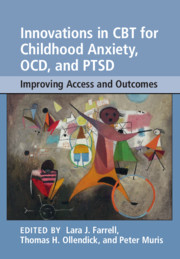Book contents
- Innovations in CBT for Childhood Anxiety, OCD, and PTSD
- Innovations in CBT for Childhood Anxiety, OCD, and PTSD
- Copyright page
- Contents
- Figures
- Tables
- Contributors
- Preface
- Acknowledgments
- Part I Anxiety Disorders
- Part II Obsessive-Compulsive Disorder
- Part III Post-Traumatic Stress Disorder
- Index
- References
Part I - Anxiety Disorders
Published online by Cambridge University Press: 12 April 2019
- Innovations in CBT for Childhood Anxiety, OCD, and PTSD
- Innovations in CBT for Childhood Anxiety, OCD, and PTSD
- Copyright page
- Contents
- Figures
- Tables
- Contributors
- Preface
- Acknowledgments
- Part I Anxiety Disorders
- Part II Obsessive-Compulsive Disorder
- Part III Post-Traumatic Stress Disorder
- Index
- References
- Type
- Chapter
- Information
- Innovations in CBT for Childhood Anxiety, OCD, and PTSDImproving Access and Outcomes, pp. 1 - 286Publisher: Cambridge University PressPrint publication year: 2019

